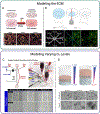Engineering of the microenvironment to accelerate vascular regeneration
- PMID: 36371337
- PMCID: PMC9742290
- DOI: 10.1016/j.molmed.2022.10.005
Engineering of the microenvironment to accelerate vascular regeneration
Abstract
Blood vessels are crucial for tissue development, functionality, and homeostasis and are typically a determinant in the progression of healing and regeneration. The tissue microenvironment provides physicochemical cues that affect cellular function, and the study of the microenvironment can be accelerated by the engineering of approaches capable of mimicking various aspects of the microenvironment. In this review, we introduce the major components of the vascular niche and focus on the roles of oxygen and the extracellular matrix (ECM). We demonstrate how vascular engineering approaches enhance our understanding of the microenvironment's impact on the vasculature towards vascular regeneration and describe the current limitations and future directions towards clinical utilization.
Keywords: extracellular matrix; hypoxia; regeneration; vascular engineering.
Copyright © 2022 Elsevier Ltd. All rights reserved.
Conflict of interest statement
Declaration of interests No interests are declared.
Figures



Similar articles
-
Generating favorable growth factor and protease release profiles to enable extracellular matrix accumulation within an in vitro tissue engineering environment.Acta Biomater. 2017 May;54:81-94. doi: 10.1016/j.actbio.2017.02.041. Epub 2017 Feb 24. Acta Biomater. 2017. PMID: 28242454
-
Recent Advancements in Decellularized Matrix-Based Biomaterials for Musculoskeletal Tissue Regeneration.Adv Exp Med Biol. 2018;1077:149-162. doi: 10.1007/978-981-13-0947-2_9. Adv Exp Med Biol. 2018. PMID: 30357688 Review.
-
The interplay between extracellular matrix and progenitor/stem cells during wound healing: Opportunities and future directions.Acta Histochem. 2021 Oct;123(7):151785. doi: 10.1016/j.acthis.2021.151785. Epub 2021 Sep 6. Acta Histochem. 2021. PMID: 34500185 Review.
-
Tissue engineering and regenerative strategies to replicate biocomplexity of vascular elastic matrix assembly.Tissue Eng Part B Rev. 2012 Jun;18(3):203-17. doi: 10.1089/ten.TEB.2011.0521. Epub 2012 Mar 2. Tissue Eng Part B Rev. 2012. PMID: 22224468 Free PMC article. Review.
-
Engineering Extracellular Microenvironment for Tissue Regeneration.Bioengineering (Basel). 2022 May 8;9(5):202. doi: 10.3390/bioengineering9050202. Bioengineering (Basel). 2022. PMID: 35621480 Free PMC article. Review.
Cited by
-
Bioengineered cardiovascular bypass grafts via in vivo self-assembly of scaffold-guided tubular tissue in rats.J Nanobiotechnology. 2025 Aug 20;23(1):574. doi: 10.1186/s12951-025-03664-9. J Nanobiotechnology. 2025. PMID: 40830966 Free PMC article.
-
Hydrogel-Encapsulated Pancreatic Islet Cells as a Promising Strategy for Diabetic Cell Therapy.Research (Wash D C). 2024 Jul 4;7:0403. doi: 10.34133/research.0403. eCollection 2024. Research (Wash D C). 2024. PMID: 38966749 Free PMC article. Review.
-
Skin organoid transplantation promotes tissue repair with scarless in frostbite.Protein Cell. 2025 Apr 18;16(4):240-259. doi: 10.1093/procel/pwae055. Protein Cell. 2025. PMID: 39363875 Free PMC article.
References
-
- Alberts BJ, Alexander; Lewis Julian; Raff Martin; Roberts Keith; Walter Peter, Blood Vessels and Endothelial Cells, in Molecular Biology of the Cell, 4th edition. 2002, Garland Science: New York.
Publication types
MeSH terms
Grants and funding
LinkOut - more resources
Full Text Sources

